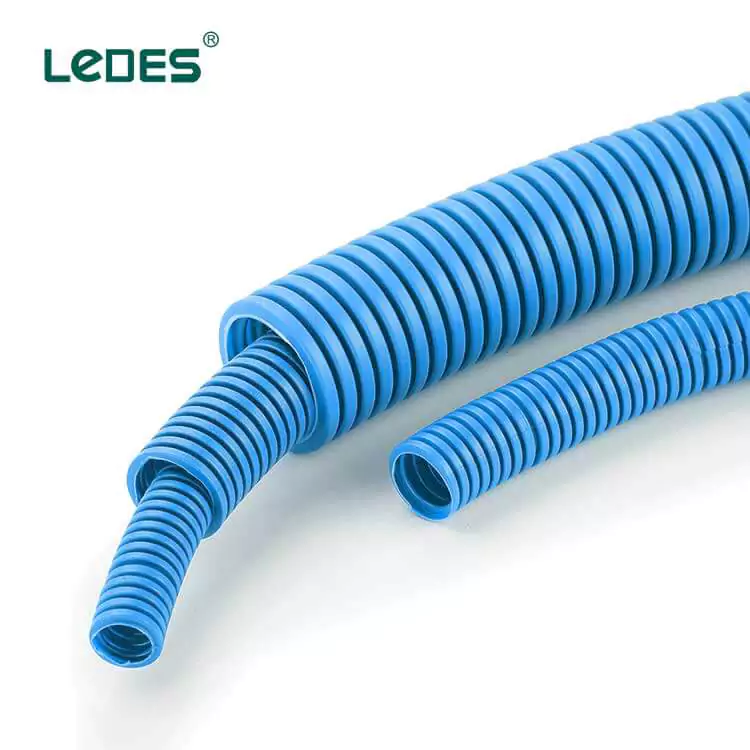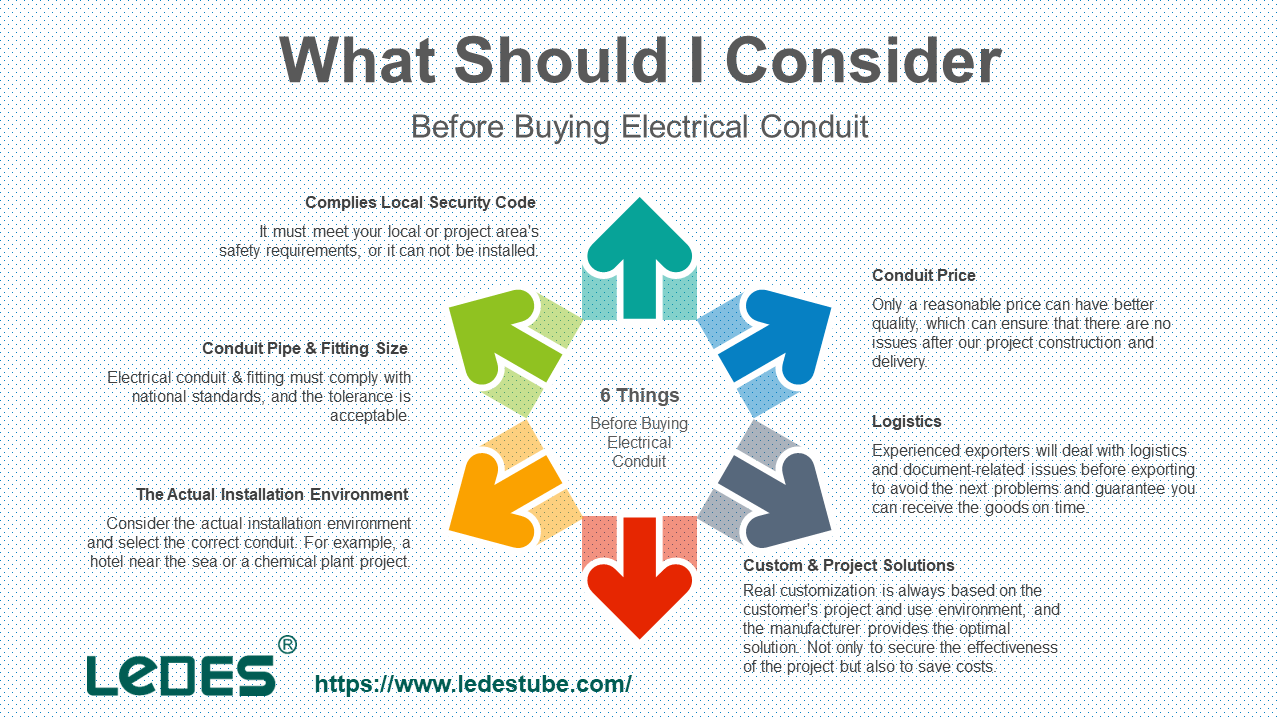
Índice
Um conduíte elétrico é um tubo usado para proteger e rotear a fiação elétrica em um edifício ou estrutura. O conduíte elétrico pode ser feito de metal, plástico, fibra ou argila cozida. A maioria dos conduítes é rígida, mas o conduíte flexível é usado para alguns propósitos.
Por que usar eletrodutos?
Independentemente do material do conduíte de fio, ele é para proteger os fios. Não apenas durante a instalação, mas também durante o uso posterior. Ele pode isolar bactérias, umidade, micro-organismos, etc., e evitar problemas de segurança causados por curtos-circuitos de fios.
Em equipamentos de grande porte, principalmente elétricos, o conduíte de fios é indispensável. Por exemplo, Projeto PV2 Al Dhafra de Abu Dhabi, Emirados Árabes Unidos participou antes de considerar que os painéis solares e os tubos de arame precisam ser expostos a ambientes extremamente severos por um longo tempo, exigindo tubos de arame de qualidade superior. Altas temperaturas e luz UV durante o dia e temperaturas extremamente baixas à noite corroerão constantemente os conduítes e fios elétricos e, se houver um problema, pode fazer com que o equipamento entre em curto e deixe de ser usado.
Algumas noções básicas de teoria
Existem diferenças entre os conduíte rígido e tubo flexível, geralmente feito de metal ou plástico. Para fins de instalação, devemos avaliar cuidadosamente seu ambiente de instalação antes de comprar para evitar alguns problemas. Por exemplo, ao instalar em um canto, a instalação é difícil devido à incapacidade de dobrar o tubo.
Em diferentes países, além dos diferentes tamanhos e especificações, mais importante, há padrões de instalação correspondentes. Por exemplo, os Estados Unidos têm o Código NEC cobrindo 50 estados. Ele deixou especificações claras para os detalhes da construção, como a profundidade enterrada do tubo de conduíte e conexões.
Seja uma instalação DIY ou uma empresa de decoração, ela deve operar de acordo com as especificações relevantes da NEC. Caso contrário, pode sofrer um curto-circuito, causando um incêndio elétrico e colocando a segurança em risco.
Se você não for um eletricista profissional, recomendamos deixar esse trabalho para um eletricista para evitar o risco de erros de instalação.
Tipos de conduítes elétricos
A classificação da indústria é geralmente baseada em materiais diferentes. Diferentes países ou padrões têm diferentes requisitos para o diâmetro externo, diâmetro interno e espessura de parede de conduítes elétricos, então haverá diferenças. Além disso, mesmo que o material seja semelhante, alguns produtos serão subdivididos para uso, como um conduíte estanque a líquidos, cuja característica é que ele pode melhorar a vedação e o desempenho estanque.
Metal
Tipo de conduíte metálico
Eletroduto metálico rígido (RMC)
Conduítes metálicos rígidos são comuns e podem ser encontrados em muitos edifícios comerciais. Geralmente são de parede espessa, resistentes e feitos de aço revestido, aço inoxidável ou alumínio.
Como edifícios comerciais de grande porte geralmente exigem alta potência, o diâmetro do fio é grosso. Para aumentar o número de fios de tração, o diâmetro desse tipo de tubo de fio é geralmente maior e a resistência ao impacto é mais forte. Ao mesmo tempo, devido ao seu grande diâmetro e resistência, ele não pode dobrar tubos e é caro.
Eletroduto rígido galvanizado (GRC)
Também é muito comum, geralmente usado em edifícios comerciais ou industriais, e o custo é mais barato do que tubos de aço inoxidável ou alumínio. A galvanização é adicionar uma camada antiferrugem, que pode garantir que o ciclo de ferrugem seja atrasado após a instalação externa ou interna.
Da mesma forma, o GRC geralmente tem paredes grossas e é adequado para projetos de construção pesados ou médios. Ele pode fornecer excelente resistência ao impacto e proteger bem os fios.
Eletroduto metálico intermediário (IMC)
Um tubo de metal com resistência ao impacto maior que EMT, mas menor que RMC, não é tão amplamente utilizado quanto os dois anteriores.
Tubulação metálica elétrica (EMT)
Geralmente chamado de Conduíte de Parede Fina, ele é mais espesso, porém mais leve que o RMC, por isso é normalmente usado para substituir produtos da série RMC.
EMT não é rosqueado, mas pode ser conectado a conexões rosqueadas. EMT é comumente usado em edifícios comerciais e industriais, geralmente produzido de aço revestido e alumínio.
Conduíte de alumínio
Semelhante aos vários tubos de metal acima mencionados, o tubo de alumínio também é rígido. Ele é geralmente usado em edifícios comerciais ou industriais, especialmente em projetos que exigem alta resistência à corrosão, como fábricas de alimentos, plantas de purificação de água, etc.
Outro ponto é que os tubos de alumínio não podem ser embutidos diretamente no concreto e precisam de um revestimento protetor antes de poderem ser usados normalmente (como a adição de um revestimento plástico).
Como o alumínio é mais leve, ele tem vantagens na instalação, como economia de mão de obra.
Metalóide
Conduíte de PVC
Atualmente, entre os conduítes não metálicos, o mais comum são os produtos de conduítes de fio de PVC, que também são o principal produto da Ledes.
Comparado com conduítes de metal, a resistência e a retardação de chamas dos conduítes de PVC são piores do que os conduítes de metal, o que é muito óbvio. Ao mesmo tempo, ele tem muitas vantagens, como menor custo, leveza, facilidade de dobrar, facilidade de transportar, não suscetível à corrosão e assim por diante. Além disso, no mercado de conduítes elétricos na América do Norte, os conduítes de PVC com diferentes espessuras de parede foram diferenciados de acordo com os usos atuais e foram amplamente aceitos na indústria.
Além disso, os acessórios para conduítes de PVC também são fáceis de adquirir, podendo atender perfeitamente às necessidades de diferentes cenários e projetos.
Conduíte de resina termoendurecível reforçado (RTRC)
RTRC é um conduíte de fibra de vidro com vantagens óbvias, como leveza, baixo custo de fabricação e forte resistência à corrosão.
Considerando as principais vantagens do RTRC, ele é amplamente utilizado em projetos internos e externos, e sua versão atualizada da série de produtos com baixa emissão de fumaça e sem halogênio também foi aplicada em projetos comerciais.
Conduíte rígido não metálico (RNC)
Um conduíte não metálico, sem rosca e com paredes lisas.
Tubulação elétrica não metálica (ENT)
As características dos tubos corrugados de parede espessa são semelhantes às dos conduítes de PVC.
O nascimento do tubo corrugado é principalmente para resolver nossas necessidades no canto ou necessidade de "virar". A ENT pode realizar os requisitos de dobra de tubos sem usar as ferramentas de dobra, e o fabricante tem acessórios especiais para venda, que são muito convenientes de usar.
Flexível
Eletroduto Metálico Flexível (FMC ou Flex)
é feito pelo enrolamento helicoidal de uma tira nervurada auto-intertravada de alumínio ou aço; a parte oca no meio pode ser conveniente para puxar o fio.
Também compensa a falta de EMT porque tem flexibilidade. O FMC pode ser aplicado em locais secos e tem resistência suficiente para proteger os fios de danos.
Vale mencionar que, como o FMC pode ser dobrado, ele pode absorver uma pequena vibração e aceitar um pequeno espaço de deslocamento. Portanto, ele pode ser aplicado a equipamentos e máquinas, como bombas de água e motores.
Eletroduto metálico flexível estanque a líquidos (LFMC)
Assim como o FMT mais uma camada de revestimento plástico, isso pode melhorar seu desempenho à prova d'água.
Da mesma forma, os acessórios adequados para LFMC reforçam o desempenho à prova d'água, como a adição de anéis de borracha de vedação.
Tubos Metálicos Flexíveis (FMT)
FMT é um raceway em vez de um conduíte. De acordo com a descrição no NEC, ele só vem em tamanhos comerciais de 1/2″ e 3/4″, enquanto o FMC é dimensionado de 1/2″ a 4″.
Em aplicações práticas, a FMT é frequentemente usada em conexões expostas de curta distância ao espaço, como a conexão do cabo do processador de lixo e a conexão do fio do aquecedor de água.
Conduíte flexível não metálico estanque a líquidos (LFNC)
Conduítes não metálicos com retardamento de chama são chamados coletivamente de conduítes, e a parede interna do conduíte possui reforços, que podem ser lisos ou corrugados.
Pode ser aplicado em locais secos, úmidos ou oleosos, como assentamento de superfícies, unidades de alta tensão, piscinas, etc.
O que devo considerar antes de comprar um eletroduto
Sejamos compradores individuais, atacadistas ou até mesmo construtores, ficamos confusos antes de comprar conduítes elétricos: a quais problemas devemos prestar atenção?
Se você está comprando produtos e acessórios elétricos a granel pela primeira vez e também está procurando compradores de fornecedores estrangeiros na Internet, aqui resumimos as precauções que podem ajudá-lo a comprar os produtos de que precisa.
6 Coisas Antes de Comprar Eletrodutos
Compartilhe esta imagem em seu site
Está em conformidade com os requisitos de segurança locais
Embora estejamos todos cientes de que os produtos de conduíte de fio elétrico em diferentes países têm tamanhos e especificações diferentes, é necessário confirmar se eles atendem aos requisitos de segurança de sua área local ou de projeto. Caso contrário, mesmo que o produto entre no canteiro de obras, ele não poderá ser instalado normalmente.
Para isso, você só precisa verificar as regulamentações relevantes em sua área antes de comprar, como o código NEC na América do Norte.
O tamanho do tubo de conduíte está em conformidade?
Importa? É muito simples. Eu consulto o vendedor, confirmo o tamanho que preciso e compro.
Para produtos que circulam por canais formais, não há problema. Mas nossos clientes reclamaram conosco que compraram o produto várias vezes e tinham quase certeza de que compraram o produto de tamanho padrão, mas descobriram que o tamanho estava errado na fase de instalação.
Seja qualquer agência de testes, como a UL, seus requisitos de teste farão requisitos sobre o diâmetro interno e o diâmetro externo do tubo de arame, mas dentro de uma faixa, a existência de tolerâncias permitidas. No entanto, uma vez que a tolerância de alguns produtos está fora da faixa, é difícil para nossos olhos nus descobrirem.
Portanto, recomendamos que você compre produtos compatíveis de marcas próprias para evitar tais problemas.
Conformidade com o tamanho do encaixe
Os conduítes e conexões de PVC também são muito importantes, como cotovelos, caixas de junção, etc. Quando a conexão tem o tamanho errado (como dissemos acima), ocorre o mesmo problema: ela não funciona.
O ambiente de instalação real
Alguns projetos têm umidade excessiva ou ficam perto do mar, e muitos locais de instalação precisam ser instalados na parede ou na esquina. Ajudaria se você considerasse mais os requisitos de design do projeto e o ambiente real de instalação.
No entanto, também precisamos equilibrar o custo e a dificuldade da construção. Por exemplo, se usarmos tubos de aço, o custo de tempo de dobra do tubo aumentará.
E suponha que seja perto do mar ou de uma fábrica de produtos químicos. Nesse caso, conduítes de metal podem ser excluídos da seleção de conduítes elétricos porque conduítes de plástico são uma escolha inteligente.
Preço do conduíte
Sem dúvida, isso está diretamente relacionado ao custo do projeto.
No entanto, para produtos com preços mais baixos do que a maioria das marcas, devemos ser vigilantes. Imagine que os comerciantes ainda precisam fornecer a você serviço pós-venda e garantia de qualidade, então como os comerciantes ganham dinheiro com produtos que são muito baratos? A única opção é reduzir a qualidade do produto, o que não é econômico para os compradores.
Por exemplo, em conduítes de PVC, os comerciantes podem usar materiais reciclados para produzir tubulações e vendê-los aos compradores a um preço menor. No entanto, a qualidade dos produtos produzidos a partir de materiais reciclados é instável. Se houver um problema, o comerciante não o resolverá bem para você porque ele já pagou o dinheiro.
Logística
A partir do momento em que seu produto estiver pronto, essa questão estará envolvida.
Parece bem simples. Mas, desde o design do pacote, a forma de carregar o contêiner e a entrega ao seu depósito por caminhão após chegar ao porto. Com um processo tão longo, ninguém pode garantir que nenhum problema acontecerá.
Proprietários de marcas experientes e com vasta experiência podem pensar e evitar problemas com antecedência antes do envio, proporcionando a você uma melhor experiência de compra.
Soluções personalizadas e de projeto
A personalização é, na verdade, OEM se você apenas alterar o tamanho ou a espessura da parede.
A personalização deve ser um produto adaptado às suas necessidades com base no projeto do cliente e nos cenários de uso reais. Matérias-primas, formulações e o desempenho do produto final são todos diferentes, que é a experiência que Ledes aprendeu com milhares de casos.
Agora, esperamos atender seus projetos com nossa experiência.
Fim
É isso. Se você tiver outras perguntas, bem-vindo ao envie o formulário de contato ou envie-nos um e-mail e responderemos às suas perguntas em até 24 horas.
Referências:








